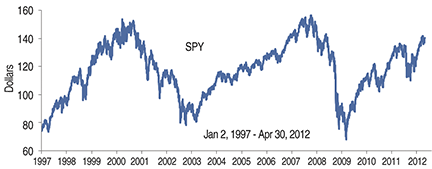CHARTING
Preparing For A Change In Direction
Warning: Bear Activity
by Anthony Trongone, PhD, CTA, CFP
When a market revisits its upper price boundaries, should traders be wary of another breakdown?
There are many moving parts to an equities downturn. Most of them arrive unexpectedly in the form of economic surprises, political instability, or random shocks. Since they are not on our radar, they are beyond our control. This study, however, is not about these unforeseen factors; its emphasis is on the market’s ability to either push past or break down from previous resistance.
Given two unsuccessful attempts of Standard & Poor’s Depositary Receipts exchange traded funds (ETFs), known as SPDRs or spiders (SPY), to break above a closing price of $160, will the third time finally be the charm? In Figure 1, you see the line chart of the spiders from its inception; it demonstrates former price resistance. More important, after retreating to previous support, its three-year price run is approaching this same upper boundary. As of April 30, 2012, it remains to be seen if it will break through this psychological barrier. If history repeats itself, another failure will produce a steep decline, pushing the spiders back down to its previous $80 price range.

FIGURE 1: THE SPY SINCE INCEPTION. The spiders reach resistance at around $160. Will this current rally break past this upper boundary, or will it slide back down to lower levels? Unlike the earlier pullback, the 2007–09 correction had a shorter but more precipitous drop.
With respect to the past, as we drift toward a price of $160 in the spiders, a cautionary stance is advisable because of its two previous failures. A break above this upper boundary is always a possibility, but this could offer less return in comparison to the risk of a sharp slide down to its lower boundary. Because of the previous downturns, most market technicians would refer to this repetitive bottom as support, circulating around the $80 mark.
My focus, however, would be on the upper boundary; most technicians consider the eight years between these two points as evidence of price resistance. But because the market is a dynamic entity, before arriving at any conclusions about the current trading environment, it is best to study the days before these past peaks for hints of another possible breakdown.
Excerpted from an article originally published in the November 2012 issue of Technical Analysis of Stocks & Commodities magazine. All rights reserved. © Copyright 2012, Technical Analysis, Inc.
Return to Contents
